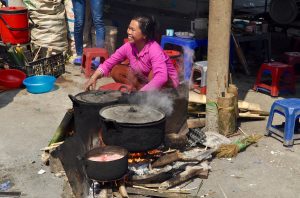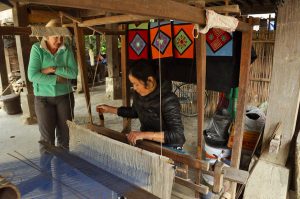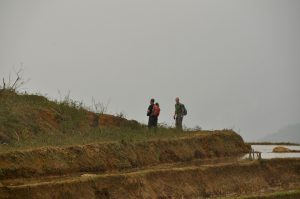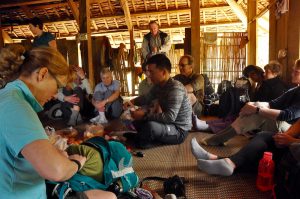Leaving Hanoi, slowly in the early morning traffic, we headed almost due west towards our trekking area. Although the trek was in the north, it was, in fact, 200km slightly south of due west of Hanoi. Gradually the flat land of Hanoi was replaced with impressive lumps of limestone. We were heading into areas inhabited by the Muong and White Thai ethnic groups.
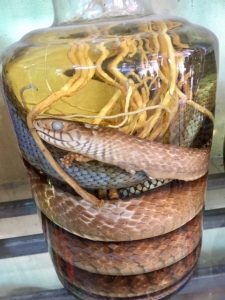 En route we stopped at a road restaurant for coffee. Vietnamese coffee is quite strong, and because they use condensed milk, very sweet. In one corner a number of men were smoking a bamboo pipe through a bucket of water. We were alerted to it by a strange gurgling sound. On a shelf there were some interesting bottles of fermenting liquid. The largest contained a snake and some roots, while a second had a number of lizards and a third, birds. It looked revolting and not something I would be prepared to knowingly try. We were learning quite quickly that the Vietnamese eat a lot of things that we would not consider as edible. If they don’t eat them, animals, as far as the Vietnamese are concerned, have medicinal properties. It seems no animal is safe. The fact that we did not see any wild animals in the countryside from the bus or during our trek suggests that there might mot be very much. We similarly saw few birds.
En route we stopped at a road restaurant for coffee. Vietnamese coffee is quite strong, and because they use condensed milk, very sweet. In one corner a number of men were smoking a bamboo pipe through a bucket of water. We were alerted to it by a strange gurgling sound. On a shelf there were some interesting bottles of fermenting liquid. The largest contained a snake and some roots, while a second had a number of lizards and a third, birds. It looked revolting and not something I would be prepared to knowingly try. We were learning quite quickly that the Vietnamese eat a lot of things that we would not consider as edible. If they don’t eat them, animals, as far as the Vietnamese are concerned, have medicinal properties. It seems no animal is safe. The fact that we did not see any wild animals in the countryside from the bus or during our trek suggests that there might mot be very much. We similarly saw few birds.
Continuing our journey, we again stopped near the top of a hill where there were a number of roadside stalls. This was the Vietnamese equivalent of a service station. Only this one had some rather unusual items. Each stall had its own wood fire with blackened pots bubbling away on them. Tubes of bamboo were stuffed with banana leaf packets of rice and placed around the edge of the fire along with skewers of meaty morsels. Tucked away in quiet corners were piglets contained in tight fitting bamboo cages. Their fate was probably not very far away.
On reaching the model village of Mai Chau we alighted from the bus for lunch. All the houses are on stilts, a traditional building style in this part of Vietnam. All life in the day time takes place under the main body of the house between the posts that hold the structure up. Our dining area was in just such a place. Taking time to wander and explore the village, many of the houses had a loom making scarves and cloths of all sizes. Each house was also a shop where they sold their goods. All around the village were lush fields of vegetables and banana trees, some of which we enjoyed for lunch.
After lunch we had a little time to sort our kit out before it was transferred on to motorbikes, the mode of transport for our kit for the next few days. A short bus ride took us to Quan Hoa, which was the starting point for our trek. As well as Mr T we also had a local guide who spoke very little English but ensured that we did not stray from the route.
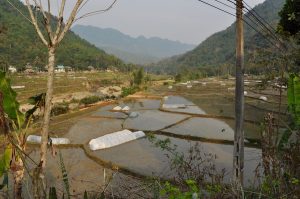 The walk was easy going, largely up a wide track that took vehicles. To our left the land rose quite steeply with plenty of trees and clumps of giant bamboo. To our left there were flooded paddy fields being prepared for the next sowing. In the corners of some of the paddies were cloches of young, fresh rice plants, waiting to be sown. There is very little mechanical assistance in this area; the individual paddies are far too small to allow that. Water buffalo pull a wooden plough back and forth to prepare the ground beneath the water, the walls are repaired by hand and, when the time comes for planting out it is all done by hand, largely by women bent double for hours on end. All the time these tasks require them to be knee deep in mud and cold water. This is a twice yearly occurrence as the climate allows two crops a year. Occasionally we saw someone wearing wellingtons, but on the whole, they were bare foot.
The walk was easy going, largely up a wide track that took vehicles. To our left the land rose quite steeply with plenty of trees and clumps of giant bamboo. To our left there were flooded paddy fields being prepared for the next sowing. In the corners of some of the paddies were cloches of young, fresh rice plants, waiting to be sown. There is very little mechanical assistance in this area; the individual paddies are far too small to allow that. Water buffalo pull a wooden plough back and forth to prepare the ground beneath the water, the walls are repaired by hand and, when the time comes for planting out it is all done by hand, largely by women bent double for hours on end. All the time these tasks require them to be knee deep in mud and cold water. This is a twice yearly occurrence as the climate allows two crops a year. Occasionally we saw someone wearing wellingtons, but on the whole, they were bare foot.
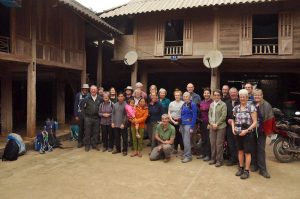 We eventually arrived in the village of Ban Hang where our homestay was. It was, again, a lovely village of stilted houses, all well-kept and cared for. They are quite large structures. They needed to be to cater for 23 of us. However, we could not enjoy the privacy of private rooms, there only being two large sleeping areas, so we split into a boys’ room and a girls’ room, for decencies sake. On the floor we had a sleeping mattress with a pillow and blankets to supplement our sleeping bags. Hanging above each mattress was a mosquito net, just in case. It was all rather comfortable and friendly.
We eventually arrived in the village of Ban Hang where our homestay was. It was, again, a lovely village of stilted houses, all well-kept and cared for. They are quite large structures. They needed to be to cater for 23 of us. However, we could not enjoy the privacy of private rooms, there only being two large sleeping areas, so we split into a boys’ room and a girls’ room, for decencies sake. On the floor we had a sleeping mattress with a pillow and blankets to supplement our sleeping bags. Hanging above each mattress was a mosquito net, just in case. It was all rather comfortable and friendly.
The family, in whose house we were staying, made us very welcome. They provided us with excellent food, yet again, and plenty of beer. However, once dinner was done and enough beer had been consumed, there was nothing much else to do other than go to bed early, and, perhaps, get to sleep before the snoring took off. Whilst there was some snoring, it seemed not to be too disturbing and I am sure that being in our beds for at least 10 hours guaranteed us sufficient hours of sleep and rest.
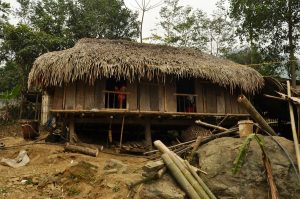 The following morning after much hand shaking with our hosts we set off. It was cloudy again and the steep forested slopes all around us looked as if they were steaming. We soon left the road and walked along footpaths, through villages, skirting along the edges of paddy fields, crossing streams and climbing small hills. Mr T would stop us to show us points of interest in villages. Little did we know, until he showed us, that many of the houses have coffins stored beneath them ready for the day when a householder should die. They were usually in houses where there were elderly people. This forward planning is not such a macabre idea. Without it, a corpse may lie waiting for many days for a coffin to be delivered from a town some distance away. Strangely, it is probably very reassuring for the eventual recipient, to know that all their affairs, once they have gone, are taken care of.
The following morning after much hand shaking with our hosts we set off. It was cloudy again and the steep forested slopes all around us looked as if they were steaming. We soon left the road and walked along footpaths, through villages, skirting along the edges of paddy fields, crossing streams and climbing small hills. Mr T would stop us to show us points of interest in villages. Little did we know, until he showed us, that many of the houses have coffins stored beneath them ready for the day when a householder should die. They were usually in houses where there were elderly people. This forward planning is not such a macabre idea. Without it, a corpse may lie waiting for many days for a coffin to be delivered from a town some distance away. Strangely, it is probably very reassuring for the eventual recipient, to know that all their affairs, once they have gone, are taken care of.
Traditionally, the deceased is buried, in their roughly hewn wooden coffin and left for three years. They are then exhumed, the bones collected and cleaned, before they are placed in an earthenware cask for a second burial, often in an adjacent paddy field to the home where they once lived. Once they are buried for the second time a proper headstone and memorial can be erected. Sometimes, we saw a cluster of such memorials where generations of the same family have been interred adjacent to each other.
Nearly every house we came across had a pond with many large fish in. Some were carp while others were Tilapia. All were a ready source of food, just like the chickens that ran around the houses and the piglets housed in pens.
We were due to have a picnic lunch on this second day of trek, in a house along the route. Unfortunately, when we arrived, there was nobody home, so our guide went in search of a house that was occupied to ask if we could have our lunch in their house. Needless to say, we were made most welcome and after removing our footwear were invited up into their main room, which covered almost the entire building. In one corner of the room there was an open fire upon which the family cooked. The smoke from it drifted up into the roof space and escaped through a series of vents in the bamboo lattice roof, but not before darkening the strips of bamboo with a layer of soot. It was a great place to eat our lunch, to observe a family at home and to enjoy the several young puppies that wanted to chew on our shoes at the foot of the stairs.
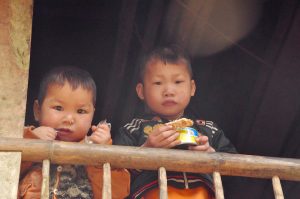 The family were rewarded for their hospitality with, not only a payment, but with any leftover food from our picnic. A real bonus when you have a young family to feed.
The family were rewarded for their hospitality with, not only a payment, but with any leftover food from our picnic. A real bonus when you have a young family to feed.
In the afternoon it was more of the same until we reached our homestay in Kho Muong village overlooking a landscape of paddy fields fringed by limestone cliffs. To begin with there was some confusion over the accommodation where we thought we would all have to cram into one room. Fortunately, the men were moved to the new house next door where we had plenty of room to spread out.
The following morning the conversation tended to focus on the erratic and loud snoring. Those closest to the perpetrator began to plot against him. Our attention was also drawn to Mike’s head, which had violently come into contact with a beam as he returned from the toilet in the night. Thankfully, his daughter Carol, a nurse, tended to his split head but nothing could repair his dented pride.
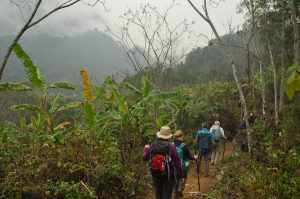 We had had some rain in the night and as we set off there was still a dampness in the air. It had made the path, largely made up of clay, very slippery. Mr T cut us all staffs to help us stay upright. As most of the walk in the morning was downhill they became essential. At one point I was walking near the back of the group when there was a cry from ahead and a call for help. Pauline had become a victim of the slippery path and fallen about fifteen feet down the slope through all the undergrowth. Or had she been pushed by Angie? There were no witnesses. Mr T ran back from ahead and was able to rescue Pauline and bring her back to the path. Fortunately, Pauline was unhurt and seemed remarkably calm considering what had just happened to her.
We had had some rain in the night and as we set off there was still a dampness in the air. It had made the path, largely made up of clay, very slippery. Mr T cut us all staffs to help us stay upright. As most of the walk in the morning was downhill they became essential. At one point I was walking near the back of the group when there was a cry from ahead and a call for help. Pauline had become a victim of the slippery path and fallen about fifteen feet down the slope through all the undergrowth. Or had she been pushed by Angie? There were no witnesses. Mr T ran back from ahead and was able to rescue Pauline and bring her back to the path. Fortunately, Pauline was unhurt and seemed remarkably calm considering what had just happened to her.
On the outskirts of a small town we came across some young boys playing football. Hovering to watch, they passed the ball to me for a shot at goal. I was hopelessly off target. Shamed by my performance, I tried again, for the ball to be saved. Another attempt missed, a fourth saved yet again. With my head hanging in shame – I could not even score against a seven year old barefoot goalkeeper – I sloped off.
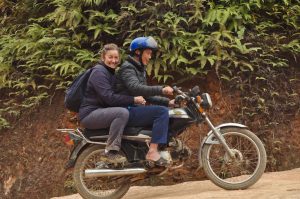 After lunch we continued our journey following the valley along a newly laid concrete road, so new the concrete was still very wet. After an hour or so we veered off the road to start the climb up to Hieu Village. At this point a few took advantage of a motorbike ride up the hill to the village. The remainder of us enjoyed the walk running parallel to a series of small waterfalls until we reached our delightful homestay in a really beautiful area of thatched, stilted houses, fish ponds, palm trees and happy, smiling faces.
After lunch we continued our journey following the valley along a newly laid concrete road, so new the concrete was still very wet. After an hour or so we veered off the road to start the climb up to Hieu Village. At this point a few took advantage of a motorbike ride up the hill to the village. The remainder of us enjoyed the walk running parallel to a series of small waterfalls until we reached our delightful homestay in a really beautiful area of thatched, stilted houses, fish ponds, palm trees and happy, smiling faces.
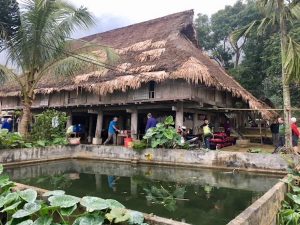 After a surprisingly quiet night (I think the fear of what might happen had put the snorer off) we set off back to the town of Pho Doan where he had lunch the day before, but by a different route. As we descended into the town the street was lined with colourful stalls, on either side, selling all items for the Tet Festival. Friendly faces greeted us from every stall.
After a surprisingly quiet night (I think the fear of what might happen had put the snorer off) we set off back to the town of Pho Doan where he had lunch the day before, but by a different route. As we descended into the town the street was lined with colourful stalls, on either side, selling all items for the Tet Festival. Friendly faces greeted us from every stall.
Shortly after arriving, the convoy of motorbikes, carrying our kit bags arrived. After a few more minutes the bus arrived, the kit loaded, our goodbyes said to our guide and the motorbike team, and we were on the bus and off on the next stage of our Vietnam adventure, Ninh Binh, Tam Coc and Halong Bay.
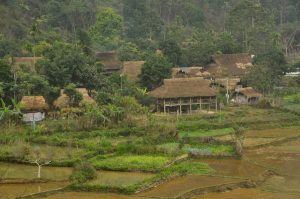 The trekking had been really enjoyable and far too short. The rural communities might not have a great deal, and their work might be hard, but they don’t have many of the hang-ups that city dwellers have. There is a peace and serenity about them as they tend to their paddy fields, their chickens and pigs. My only disappointment is that we did not see the sun during our trek, we did not see the hills at their best, but we did see enough to lure me back at some point in the future.
The trekking had been really enjoyable and far too short. The rural communities might not have a great deal, and their work might be hard, but they don’t have many of the hang-ups that city dwellers have. There is a peace and serenity about them as they tend to their paddy fields, their chickens and pigs. My only disappointment is that we did not see the sun during our trek, we did not see the hills at their best, but we did see enough to lure me back at some point in the future.

